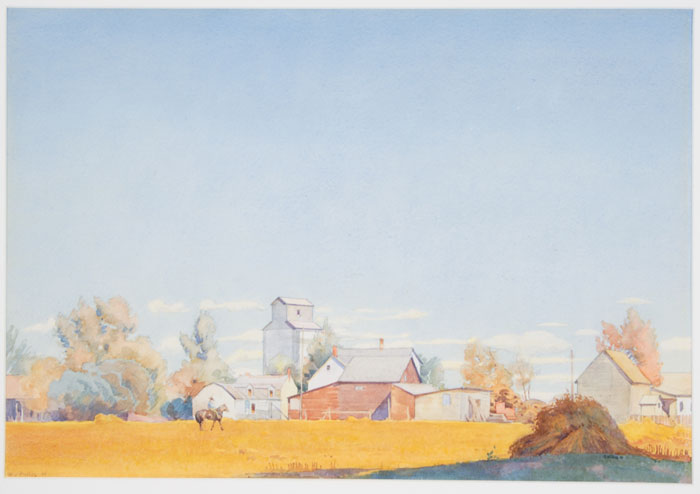Walter J. Phillips Grain Elevator
The University of Winnipeg is fortunate to have two artworks – a rare portrait in oils and a more typical watercolour landscape – in its collection by nationally recognized artist, teacher and writer Walter J. Phillips (1884-1963). Deeply respected both for his watercolours and for his colour woodblock prints, Phillips was born and raised in England where he studied at the Birmingham School of Art. Spending his formative years in multiple English counties influenced his chosen genre and Phillips’ landscapes were an outlet for his deep respect for nature. In an unpublished typescript titled “Wet Paint” the artist wrote, “The beauty and the wonder of Nature were as alluring as the pursuit of Art and made of me a landscape painter.” (45)
In 1913, Phillips immigrated to Winnipeg with his wife and infant son. For several years, he was an instructor at St. John’s Technical High School and wrote a regular art column for the Winnipeg Tribune. In his own work, Phillips applied English watercolour techniques to the prairie landscape. His early Canadian images consist largely of scenes from Lake of the Woods where he and his family rented a cottage each summer. Starting in 1926, Phillips traveled west and began painting the Rocky Mountains and the people and landscapes of the British Columbia coast. A great deal of his work during the 1930s, however, also took inspiration from his wanderings around Manitoba. A much-loved subject was the grain elevator, upon which he commented in Duncan Campbell Scott’s 1947 monograph Walter J. Phillips: "You can see an elevator ten miles away as you drive along a prairie road. We used to drive so much and over such uninteresting ground that elevators were glimpsed with joy. They stood up like beacons, and betokened a village, with gas or food or whatever our needs might be." (Scott, 26)
Phillips often identified the specific location of his elevator paintings and Grain Elevators in the University’s collection may in fact depict Headingly, Manitoba. This work reflects the characteristic control and sensitivity with which Phillips handled his subjects and it was painted when the artist was in his prime; he had just been elected a full member of the Royal Canadian Academy of the Arts in 1933.
According to the University of Winnipeg’s second president, Dr. Harry Duckworth, Grain Elevators was a gift to Wesley College (one of the University’s founding colleges) from its graduating class of 1935 of which he was a member. At that time it was customary for graduates to make a collective donation to the small school that had supported their undergraduate learning experience. The women of the class solicited donations and Mary Phillips, the artist’s daughter who completed her studies at Wesley College a year later, made arrangements to purchase the painting.
Phillips depicted grain elevators in different Manitoba towns at various points in his career in colour woodcuts as well. Phillips was internationally acclaimed during his lifetime for his proficiency in the medium derived from the Japanese method. Through the skillful superimposition of many layers of transparent water-based inks, he created images of great beauty, subtlety and depth. Phillips influenced several generations of printmakers and almost single-handedly made the colour woodcut popular with artists across the country through examples of his work and the technical manual he wrote in 1926 called The Technique of the Colour Woodcut.
In 1941, Phillips moved to Calgary to teach at the Alberta Institute of Technology and Art (now known as the Alberta College of Art and Design University). He later retired to Victoria, where he died, but he is most often recognized as a Winnipeg artist and his contribution to the development of the local art scene was significant and included mentorship of many artists, including Alison Newton whose work is also represented in the University’s art collection.
The Glenbow Museum in Calgary holds the largest collection of Phillips’ work - approximately 1000 pieces - including original print blocks, sketchbooks, drawings, watercolours, and prints. In Winnipeg, a significant number of his artworks can be found at the Pavilion Gallery in Assiniboine Park.
Phillips is one of Canada’s most celebrated artists. Portraying landscapes from the west to east coast, few others have left such an extensive catalogue of Canadian art.
Kadi Badiou
Curatorial Assistant Intern
August 2017
Sources
Cooke, W.M.E. Documentation of telephone interview with Dr. H.E. Duckworth. March 21, 1984. University of Winnipeg art collection artwork file.
Gibson, Jennifer. (Re)Visiting the Collection: Selections of Manitoba Art from The University of Winnipeg. Winnipeg: University of Winnipeg, 2008.
Scott, Duncan Campbell. Walter J. Phillips. Toronto: Ryerson Press, 1947.
“Wet Paint,” p.45 unpublished typescript, Crabb Collection. In Douglas Cole. “Out of the Mainstream: Walter J. Phillips and the Context of Canadian Art”. Manitoba History. Number 3 (1982). Accessed August 8, 2017.

